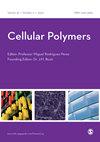Cell structure and mechanical properties of microcellular PLA foams prepared via autoclave constrained foaming
IF 1.3
4区 医学
Q4 MATERIALS SCIENCE, BIOMATERIALS
引用次数: 11
Abstract
Microcellular polylactic acid (PLA) foams with various cell size and cell morphologies were prepared using supercritical carbon dioxide (sc-CO2) solid-state foaming to investigate the relationship between the cell structure and mechanical properties. Constrained foaming was used and a wide range of cell structures with a constant porosity of ∼75% by tuning saturation pressure (8–24 MPa) was developed. Experiments varying the saturation pressure while holding other variables’ constant show that the mean cell size and the mean cell wall thickness decreased, while the cell density and the open porosity increased with increase of pressure. Tensile modulus of PLA foams decreased with increasing the saturation pressure, but the specific tensile modulus of PLA foams was still 15–80% higher than that of solid PLA. Tensile strength and elongation at break first increased with increasing saturation pressure up to 16 MPa and then decreased with further increasing saturation pressure (20 MPa and 24 MPa) at which opened-cell structure produced. Compressive modulus, compressive strength, and compressive yield stress also followed the same variation trend. The results indicated that not only cell size plays an important role in properties of PLA foams but also cell morphology can influence these properties significantly.高压釜约束发泡法制备微孔PLA泡沫的细胞结构和力学性能
采用超临界二氧化碳(sc-CO2)固态发泡法制备了具有不同孔尺寸和孔形态的微孔聚乳酸(PLA)泡沫,研究了其孔结构与力学性能的关系。使用了限制性发泡,并通过调节饱和压力(8–24 MPa)开发了一系列恒定孔隙率为~75%的细胞结构。在保持其他变量不变的情况下改变饱和压力的实验表明,随着压力的增加,平均孔尺寸和平均孔壁厚度减小,而孔密度和开孔率增加。PLA泡沫的拉伸模量随着饱和压力的增加而降低,但其比拉伸模量仍比固体PLA高15-80%。拉伸强度和断裂伸长率首先随着饱和压力的增加而增加,最高可达16MPa,然后随着饱和压力(20MPa和24MPa)的进一步增加而降低,在饱和压力下产生开孔结构。压缩模量、压缩强度和压缩屈服应力也遵循相同的变化趋势。结果表明,泡孔尺寸不仅对PLA泡沫的性能起着重要作用,而且泡孔形态也会对这些性能产生显著影响。
本文章由计算机程序翻译,如有差异,请以英文原文为准。
求助全文
约1分钟内获得全文
求助全文
来源期刊

Cellular Polymers
工程技术-材料科学:生物材料
CiteScore
3.10
自引率
0.00%
发文量
9
审稿时长
3 months
期刊介绍:
Cellular Polymers is concerned primarily with the science of foamed materials, the technology and state of the art for processing and fabricating, the engineering techniques and principles of the machines used to produce them economically, and their applications in varied and wide ranging uses where they are making an increasingly valuable contribution.
Potential problems for the industry are also covered, including fire performance of materials, CFC-replacement technology, recycling and environmental legislation. Reviews of technical and commercial advances in the manufacturing and application technologies are also included.
Cellular Polymers covers these and other related topics and also pays particular attention to the ways in which the science and technology of cellular polymers is being developed throughout the world.
 求助内容:
求助内容: 应助结果提醒方式:
应助结果提醒方式:


